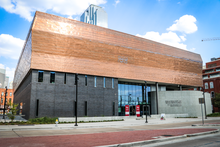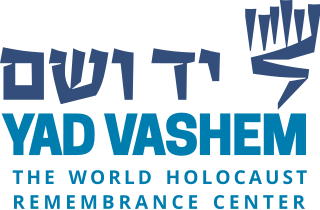
Yad Vashem is Israel's official memorial to the victims of the Holocaust. It is dedicated to preserving the memory of the dead; honoring Jews who fought against their Nazi oppressors and Gentiles who selflessly aided Jews in need; and researching the phenomenon of the Holocaust in particular and genocide in general, with the aim of avoiding such events in the future.

The United States Holocaust Memorial Museum (USHMM) is the United States' official memorial to the Holocaust. Adjacent to the National Mall in Washington, D.C., the USHMM provides for the documentation, study, and interpretation of Holocaust history. It is dedicated to helping leaders and citizens of the world confront hatred, prevent genocide, promote human dignity, and strengthen democracy.

The Museum of Jewish Heritage, located in Battery Park City in Manhattan, New York City, is a memorial to those who perished in the Holocaust. The building, designed by Roche-Dinkeloo, is topped by a pyramid structure called the Living Memorial to the Holocaust. The museum opened in 1997. More than 1.5 million visitors from all over the world have visited the museum. The mission statement of the museum is "to educate people of all ages and backgrounds about the broad tapestry of Jewish life in the 20th and 21st centuries — before, during, and after the Holocaust."

The Museum of Tolerance (MOT), a multimedia museum in Los Angeles, California, United States, is designed to examine racism and prejudice around the world with a strong focus on the history of the Holocaust. The museum was established in 1993, as the educational arm of human rights organization, the Simon Wiesenthal Center. MOT also deals with atrocities in Cambodia and Latin America, along with issues like bullying and hate crimes. The MOT has an associated museum and professional development multi-media training facility in New York City.

The Virginia Holocaust Museum (VHM) is a public history museum, located in Richmond, Virginia. The museum is dedicated to depicting the Holocaust through the personal stories of its victims.

The Montreal Holocaust Museum is a museum located in Montreal, Quebec, Canada, that is dedicated to educating people of all ages and backgrounds about the Holocaust, while sensitizing the public to the universal perils of antisemitism, racism, hate and indifference. Through the museum, its commemorative programs and educational initiatives, it aims to promote respect for diversity and the sanctity of human life. The Museum was founded in 1979 as the Montreal Holocaust Memorial Centre and is Canada's first and only recognized Holocaust museum.

The Holocaust Museum Houston is located in Houston's Museum District, in the U.S. state of Texas. The Holocaust memorial museum is the fourth largest in the U.S., and opened in 1996.
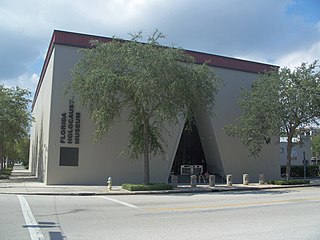
The Florida Holocaust Museum is a Holocaust museum located at 55 Fifth Street South in St. Petersburg, Florida. Founded in 1992, it moved to its current location in 1998. Formerly known as the Holocaust Center, the museum officially changed to its current name in 1999. It is one of the largest Holocaust museums in the United States. It was founded by Walter and Edith Lobenberg both of whom were German Jews who escaped persecution in Nazi Germany by immigrating to the United States. Holocaust survivor Elie Wiesel served as Honorary Chairman and cut the ribbon at the 1998 opening ceremony. The Florida Holocaust Museum is one of three Holocaust Museums that is accredited by the American Alliance of Museums. The museum works with the local community and survivors of the Holocaust to spread awareness and to educate the public on the history of the Holocaust.

International Holocaust Remembrance Day is an international memorial day on 27 January commemorating the tragedy of the Holocaust that occurred during the Second World War. It commemorates the genocide that resulted in the deaths of 6 million Jews and 11 million others, by the Nazi regime and its collaborators. It was designated by the United Nations General Assembly resolution 60/7 on 1 November 2005 during the 42nd plenary session. The resolution came after a special session was held earlier that year on 24 January 2005 during which the United Nations General Assembly marked the 60th anniversary of the liberation of the Nazi concentration camps and the end of the Holocaust.
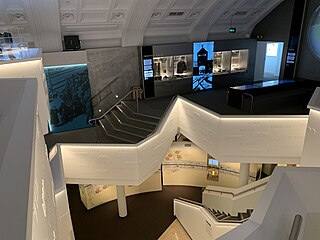
The Sydney Jewish Museum is a history museum in Sydney, Australia, which documents the Holocaust, the history of the Jewish people in Australia, and explores human rights issues in Australia.

Carla Garapedian is a filmmaker, director, writer and broadcaster. She directed Children of the Secret State about North Korea and was an anchor for BBC World News. After leaving BBC World, she directed Dying for the President" about Chechnya, Lifting the Veil, about women in Afghanistan, Iran Undercover and My Friend the Mercenary about the coup in Equatorial Guinea. Her feature, Screamers, was theatrically released in the U.S. in December 2006 and early 2007, and was on Newsweek's pick of non-fiction films for 2006/7. The Independent called it "powerful" and Larry King for CNN described it as "a brilliant film. Everyone should see it." The New York Times deemed it "invigorating and articulate," while the Los Angeles Times called it "eye-opening." "Carla Garapedian is a screamer, too," said the Washington Post.
The Holocaust Center of Northern California (HCNC) is a non-profit organization formed to ensure that the lessons of the Holocaust never be forgotten. HCNC provides services and programs to fulfill its mission of education, research and remembrance.

The Illinois Holocaust Museum and Education Center is a museum located in Skokie, Illinois near Chicago.
Holocaust studies is a scholarly discipline that encompasses the historical research and study of the Holocaust. Institutions dedicated to Holocaust research investigate the multidisciplinary and interdisciplinary aspects of Holocaust methodology, demography, sociology, and psychology. It also covers the study of Nazi Germany, World War II, Jewish history, religion, Christian-Jewish relations, Holocaust theology, ethics, social responsibility, and genocide on a global scale.Exploring trauma, memories, and testimonies of the experiences of Holocaust survivors, human rights, international relations, Jewish life, Judaism, and Jewish identity in the post-Holocaust world are also covered in this type of research.

USC Shoah Foundation – The Institute for Visual History and Education, formerly Survivors of the Shoah Visual History Foundation, is a nonprofit organization dedicated to making audio-visual interviews with survivors and witnesses of the Holocaust and other genocides, a compelling voice for education and action. It was established by Steven Spielberg in 1994, one year after completing his Academy Award-winning film Schindler's List. The original aim of the Institute was to record testimonies of survivors and other witnesses of the Holocaust as a collection of videotaped interviews. In January 2006, the Foundation partnered with and relocated to the University of Southern California and was renamed the USC Shoah Foundation – The Institute for Visual History and Education.

The Cape Town Holocaust & Genocide Centre began as Africa's first Holocaust centre. The facility is one of three centres established by the South African Holocaust and Genocide Foundation. The other two are located in Johannesburg and Durban. It is in the Albow Centre in Gardens, central Cape Town. They aim to display stories of the survivors and ensure that the atrocities of the Holocaust are not forgotten. The museum has a permanent exhibition that combines text, archival photographs, film footage, documents, multimedia displays and recreated environments. They also offer educational programmes of various types, for groups such as students or educators. The Holocaust is taught within a South African context; lessons on racism and the apartheid are mixed together.

Witness: Passing the Torch of Holocaust Memory to New Generations is a large format volume, published by Canadian Second Story Press, inspired by a 2014 United Nations exhibit of reflections and images of Holocaust survivors and students who have traveled on the March of the Living since 1988. The exhibit and the book are intended to educate a new generation of students about the atrocities of the Second World War. In collaboration with March of the Living, an organization that spearheads visits to the Polish grounds where Nazi atrocities occurred, Toronto religious leader and Holocaust educator Eli Rubenstein compiled this book which includes an introduction from Pope Francis.

Education about the Holocaust or Holocaust education refers to efforts, in formal and non-formal settings, to teach about the Holocaust. Teaching and Learning about the Holocaust addresses didactics and learning, under the larger umbrella of education about the Holocaust, which also comprises curricula and textbooks studies. The expression “Teaching and Learning about the Holocaust” is used by the International Holocaust Remembrance Alliance.
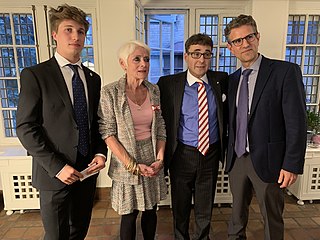
Naomi Kramer is a Canadian curator and president of the Holocaust Education and Genocide Prevention Foundation.
Abram Piasek was a survivor of four death camps in Poland and Germany, and a veteran of the U.S. Army. He shared his story of survival with thousands of students and people throughout North Carolina at schools, universities, libraries, and military bases. At the end of the war, Piasek survived because the train he was on, which he later learned was bound for Dachau, was bombed by allied forces.
